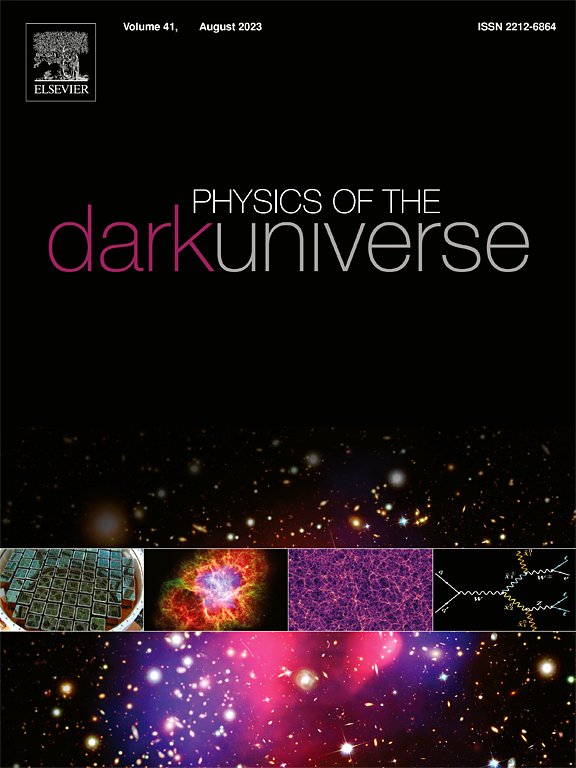Impact of Kalb–Ramond fields and perfect fluid dark matter on black hole shadows and gravitational lensing
IF 6.4
2区 物理与天体物理
Q1 ASTRONOMY & ASTROPHYSICS
引用次数: 0
Abstract
We study the shadow and gravitational lensing features of static, spherically symmetric black holes in the presence of a Kalb–Ramond (KR) field and perfect fluid dark matter (PFDM). The KR field, derived from string theory, has a Lorentz-violating parameter , whereas PFDM is defined by the density parameter . The resulting KR-PFDM metric modifies null geodesics, photon spheres, and related observables. We analyze photon motion in vacuum and in dispersive plasma environments, considering homogeneous, singular isothermal sphere (SIS), and non-singular isothermal sphere (NSIS) plasma profiles. The numerical results show that, in vacuum, increasing from to 0.2 reduces the photon sphere radius from 3.00 to 2.85 for fixed , while raising from 0.1 to 0.3 in reduces by . Consequently, the shadow radius decreases by up to 10% for the same parameter variations. In a homogeneous plasma with , the shadow radius is smaller by 15% compared to vacuum. Weak lensing analysis shows that for an impact parameter , the deflection angle decreases from 1.2 rad to 0.9 rad as increases from to 0.2 in a uniform plasma, with SIS and NSIS profiles producing progressively smaller deflections. The magnifications of the images drop by 8% as increases from 0.1 to 0.3, while the larger slightly enhances the magnification. Our results demonstrate that both Lorentz symmetry breaking and PFDM act to compactify the photon sphere, shrink the shadow, and weaken gravitational lensing signatures. The magnitude of these effects, comparable to or exceeding 5%–15% in key observables, suggests that future high-resolution VLBI facilities such as ngEHT could place meaningful constraints on and .
卡布拉蒙场和完美流体暗物质对黑洞阴影和引力透镜的影响
本文研究了在Kalb-Ramond (KR)场和完美流体暗物质(PFDM)存在下静态球对称黑洞的阴影和引力透镜特征。由弦理论导出的KR场有一个违反洛伦兹的参数a,而PFDM由密度参数β定义。由此产生的KR-PFDM度量修改了零测地线、光子球和相关的观测值。我们分析了光子在真空和色散等离子体环境中的运动,考虑均匀、奇异等温球(SIS)和非奇异等温球(NSIS)等离子体剖面。数值结果表明,在真空中,当固定β=0.2时,将a从−0.2增加到0.2,光子球半径rph从~ 3.00 M降低到~ 2.85 M,而在a=0时,将β从0.1提高到0.3,rph降低约5%。因此,对于相同的参数变化,阴影半径rsh减少高达10%。在ωp2/ω02=0.5的均匀等离子体中,阴影半径比真空小约15%。弱透镜分析表明,当冲击参数b=5M时,在均匀等离子体中,当a从- 0.2增加到- 0.2时,偏转角α δ从~ 1.2 rad减小到~ 0.9 rad,其中SIS和NSIS剖面产生的偏转逐渐减小。当β从0.1增加到0.3时,图像的放大倍率下降~ 8%,而较大的a略增强放大倍率。我们的研究结果表明,洛伦兹对称破缺和PFDM都能使光子球紧化,缩小阴影,减弱引力透镜特征。这些效应的大小,在关键观测值中相当于或超过5%-15%,表明未来的高分辨率VLBI设施,如ngEHT,可以对a和β施加有意义的约束。
本文章由计算机程序翻译,如有差异,请以英文原文为准。
求助全文
约1分钟内获得全文
求助全文
来源期刊

Physics of the Dark Universe
ASTRONOMY & ASTROPHYSICS-
CiteScore
9.60
自引率
7.30%
发文量
118
审稿时长
61 days
期刊介绍:
Physics of the Dark Universe is an innovative online-only journal that offers rapid publication of peer-reviewed, original research articles considered of high scientific impact.
The journal is focused on the understanding of Dark Matter, Dark Energy, Early Universe, gravitational waves and neutrinos, covering all theoretical, experimental and phenomenological aspects.
 求助内容:
求助内容: 应助结果提醒方式:
应助结果提醒方式:


